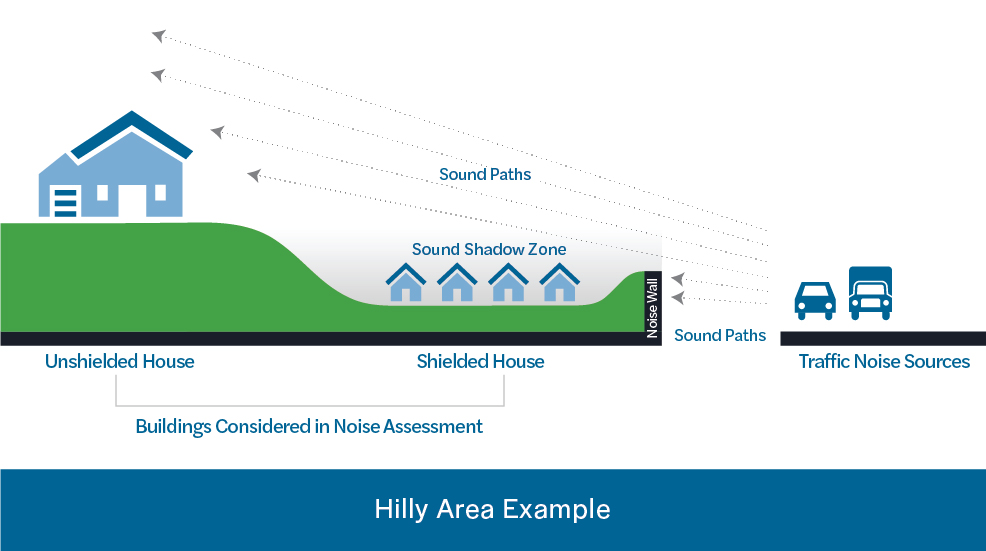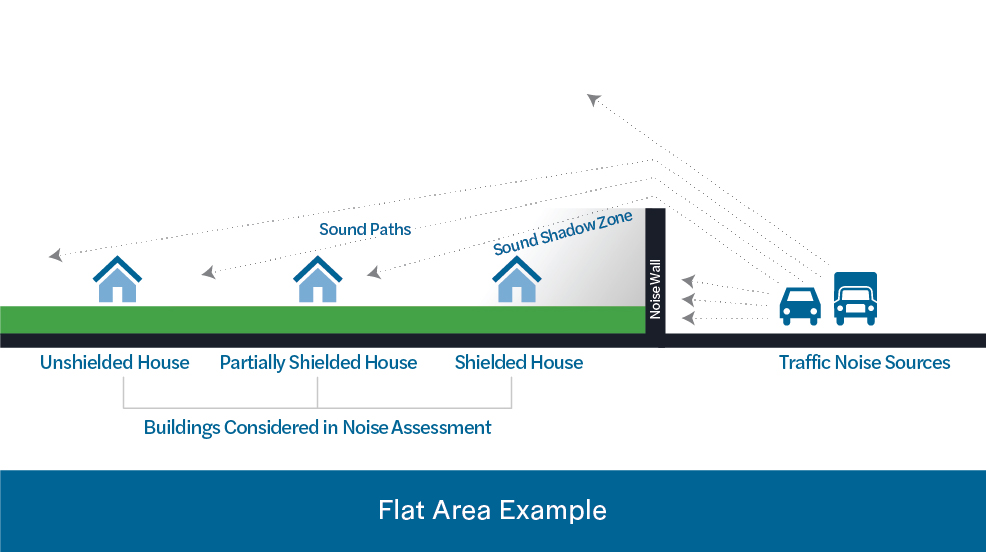Traffic Noise
There are many ways to reduce noise. Noise walls are one tool, but berms and highway design can help reduce noise as well. The density of receptors and the distance from the roadway projects are among many factors considered when determining if a noise wall is reasonable and feasible. Sometimes, noise walls will not reduce the noise because of the location of the road. Each new road or modification of an existing road that adds capacity must be examined individually to determine what measures can be taken. This pamphlet will briefly describe how SCDOT determines when noise abatement will be provided and provides contact information if you have more questions.
How will the I-526 LCC WEST project address potential traffic noise
All projects that add capacity to a corridor are required to perform noise studies during the development of the project. Noise measurements have been taken along the corridor and a detailed noise analysis is currently underway. At the public hearing in late 2020, the project team will present the noise analysis findings and any proposed locations of noise barriers for public input. The determination of whether a noise barrier is feasible and reasonable on a project is a process performed in accordance with the SCDOT Noise Policy.
How is traffic noise evaluated?
For the first step in the process, SCDOT experts go to homes, churches, businesses, or other places that may be affected by a proposed highway project and use special equipment to monitor existing noise.
Next, complex computer modeling is used to predict expected noise changes at these locations once the road is built and traffic increases.
Then, it must be determined which noise-sensitive locations were permitted before the Date of Public Knowledge and, therefore, are eligible for noise reduction.
If the anticipated noise increase is MORE than the level defined by SCDOT policy, we begin to consider possible ways to reduce the noise, such as with noise walls and earth berms, at all eligible locations.
When are noise walls considered?
Whenever a highway project uses federal funds and meets the Federal Highway Administration’s (FHWA’s) criteria of a Type I project, the potential for increased traffic noise and how to reduce it must be evaluated. For all Type I projects where traffic noise impacts are predicted, noise abatement (typically in the form of noise walls) must be considered. Potential traffic noise increases are evaluated for any building permitted before the “Date of Public Knowledge.”
What is the “Date of Public Knowledge”?
This is the date that the public (and local government) is notified of the future path of the road and is the date of approval of the Categorical Exclusion (CE), the Finding of No Significant Impact (FONSI), or the Record of Decision (ROD).”
Are there alternatives to noise walls?
Other options may also help reduce traffic noise. Some of these may be provided by SCDOT, and others are alternatives that might be considered by private developers or homeowners.
- Land use design – if homes are set back from the road or are separated from the road by other development, the noise levels may be lower.
- Noise berm (earth or other materials) and combination berm/wall systems
- Types of vehicles/speed limits – noise can be reduced with lower speed limits and truck restrictions on a road. However, reducing the speed limit below the appropriate speed based on the design will have only a moderate effect on traffic noise and may actually increase the number of accidents on the roadway
- Building insulation – noise insulation in buildings, such as replacing doors and windows or adding insulation to walls and attics
When do noise walls work?
Sounds travels very much like water or light. It follows the easiest path over, under, and around things in its path. The farther away from the source of the sound, the lower the noise.
Noise walls do not work if the source of the noise can be seen. The noise will simply travel through that opening much like water will flow through a crack in a dam. If a building is located higher than a noise wall, the noise will flow over the wall to the building.
The graphic shows two examples of noise walls located between buildings and a road. In both cases, the wall will shield one of the houses but will not shield them all.
Noise walls do not completely eliminate all noise.


How does SCDOT decide which communities get noise walls and which do not?
Once SCDOT has completed the technical evaluation, they also consider the following questions:
- Will a noise wall reduce the noise enough to justify its construction? Sometimes, a noise wall will not reduce the noise enough to be considered reasonable and/or feasible.
- Is a noise wall technically feasible? Every road is different, many factors are considered such as topography, safety, drainage, utilities, maintenance of the wall, and whether driveways and side road access will be impacted.
- How many people will hear a difference in noise? Is that number high enough to justify the cost? Sometimes, the cost is too high to build a wall when compared to the benefits received.
- Does a simple majority of property owners and tenants who receive a predicted noise level reduction due to construction of a noise wall actually want the wall? Public preference for or against a wall is obtained through a balloting process.
What assurances are there that noise impacts will be considered and that noise walls will be built where needed?
Federal regulations require SCDOT to conduct noise studies and consider the impacts of a highway expansion project on nearby residents when a project is developed with federal funds. SCDOT’s Noise Abatement Policy describes the process that SCDOT uses to determine the reasonableness and feasibility of constructing noise walls.
To learn more about how SCDOT considers noise impacts during the project development process, we invite you to watch the “Highway Traffic Noise” educational video.
Why was a noise barrier not constructed on Interstate 26 as part of the 2008 widening and interchange improvements at Remount and Aviation?
The construction of noise barriers on federally funded projects depends upon a number of factors including engineering feasibility, sound level reduction, cost, and public input. The noise analysis for the 2008 project determined that a noise barrier was not reasonable due to prohibitive costs. However, SCDOT would be required to evaluate noise impacts and assess the need for noise barrier if I-26 is widened in the future.
Where are we in the SCDOT noise analysis process? What happens next?
A detailed study was conducted to determine the anticipated changes in traffic noise as a result of the project and where potential noise mitigation strategies might be needed. Increases in traffic noise levels would be expected throughout much of the corridor as a result of the project. SCDOT evaluated noise impacts within the corridor in accordance with federal guidelines and the Department’s noise abatement policy. As a result of this evaluation, noise barriers are proposed at the following locations:
- West of I-526 between Paul Cantrell Boulevard and Ashley River Road in West Ashley
- West of I-526 between Ashley River Road and the Ashley River in West Ashley
- East of I-526 and between Paul Cantrell Boulevard and Ashley River Road in West Ashley
- East of I-526 between Ashley River Road and the Ashley River in West Ashley
- I-526 Eastbound between International Boulevard and I-26
A final decision on noise barrier construction will be made upon completion of the project’s final design and the public involvement process.
In locations where the construction of noise barriers did not meet SCDOT’s criteria for feasibility and/or reasonableness, alternative noise abatement measures are being considered, including quieter bridge expansion joints and quieter concrete surfaces.
Additional Resources
- Answering Your Questions about Highway Traffic Noise (PDF: English | Spanish)
- Noise Scale: Common Sound Levels
- SCDOT Noise Policy
